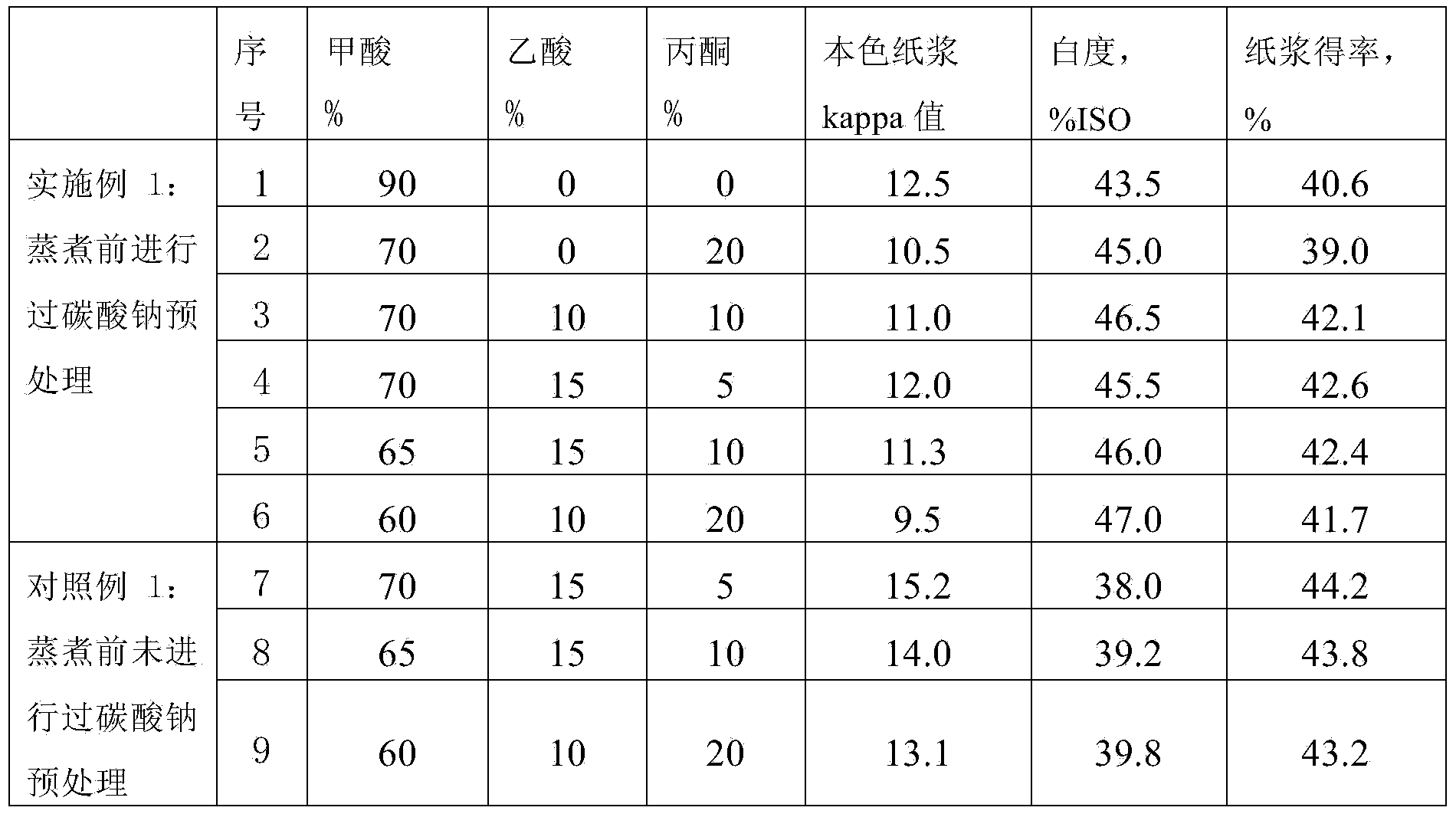Unbleached pulp production method for increasing whiteness of pulp
A production method and pulping technology, applied in papermaking, textiles and papermaking, pulping with organic solvents, etc., can solve the problems of low whiteness, low whiteness of natural pulp, environmental pollution of natural pulp, etc., and achieve the effect of improving whiteness
- Summary
- Abstract
- Description
- Claims
- Application Information
AI Technical Summary
Problems solved by technology
Method used
Image
Examples
Embodiment 1
[0042] Example 1. Making natural pulp from poplar wood
[0043] Cut poplar wood into wood chips with a size of about 30mm×4mm×2mm. Firstly, sodium percarbonate is used for pretreatment. The pretreatment conditions are: sodium percarbonate 2.5%, sodium hydroxide 1.0%, and pentasodium diethyltriaminepentaacetic acid. 0.2%, add water, liquid ratio 1:6, pretreatment temperature 110℃, time 90min. After pretreatment, it is washed with hot water at 60-80°C and concentrated to a dryness of 45% by weight. Then organic solvent cooking is carried out, the liquid ratio is 1:8, and the cooking conditions are: the organic solvent concentration (v / v) in the cooking liquid is 90%, the balance is water; the temperature is 135°C, and the time is 30 minutes. The organic solvent is a combination of formic acid, acetic acid and acetone, wherein the concentration (%, volume ratio) of formic acid, acetic acid and acetone is changed and numbered 1-6 respectively. After cooking, the pulp is washed with...
Embodiment 2
[0049] Example 2: Making natural paper pulp from bamboo raw materials
[0050] The bamboo is cut into bamboo pieces with a size of about 25×3.5mm×1.8mm, and first pretreated with sodium percarbonate. The treatment conditions are: sodium percarbonate 3.0%, sodium hydroxide 1.0%, diethyltriaminepentaacetic acid Sodium 0.2%, add water, liquid ratio 1:8, temperature 120℃, time 90min. After pretreatment, washing is carried out, and then organic solvent cooking is carried out. The cooking conditions are: the concentration of organic solvent (v / v) in the cooking liquor is 85%, among which the concentrations of formic acid, acetic acid and acetone (v / v) are 65% and 10 % And 10%, liquid ratio 1:8, temperature 140℃, time 40min. After cooking, the pulp is washed with 80-85℃ formic acid and 80-90℃ hot water. The kappa value of the obtained natural color pulp is 16.5, the whiteness is 42.2% ISO, and the yield is 42.0%.
Embodiment 3
[0052] Example 3 Making unbleached pulp from wheat straw
[0053] Cut wheatgrass into grass slices with a length of about 25mm, and first use sodium percarbonate for pretreatment. The pretreatment conditions are: sodium percarbonate 3.0%, diethyltriaminepentaacetic acid pentasodium 0.2%, water, liquid ratio 1:7, The temperature is 125°C, and the pretreatment time is 90 minutes. Washing after pretreatment, and then organic solvent cooking. The cooking conditions are: the concentration of organic solvent in the cooking liquor is 85% (v / v), in which the concentration of formic acid (v / v) is 60%, and the concentration of acetic acid (v / v) is 10 %, acetone concentration (v / v) 15%, liquid ratio 1:8, temperature 130°C, time 30min. After cooking, the pulp is washed with 80-85℃ formic acid and 80-90℃ hot water. The kappa value of the obtained natural color pulp is 9.5, the whiteness is 44.0% ISO, and the yield is 41.0%.
PUM
| Property | Measurement | Unit |
|---|---|---|
| whiteness | aaaaa | aaaaa |
| whiteness | aaaaa | aaaaa |
Abstract
Description
Claims
Application Information
 Login to View More
Login to View More - R&D
- Intellectual Property
- Life Sciences
- Materials
- Tech Scout
- Unparalleled Data Quality
- Higher Quality Content
- 60% Fewer Hallucinations
Browse by: Latest US Patents, China's latest patents, Technical Efficacy Thesaurus, Application Domain, Technology Topic, Popular Technical Reports.
© 2025 PatSnap. All rights reserved.Legal|Privacy policy|Modern Slavery Act Transparency Statement|Sitemap|About US| Contact US: help@patsnap.com

